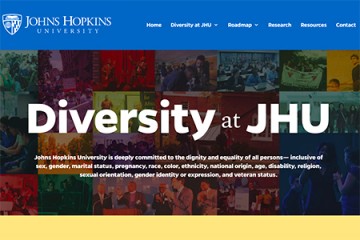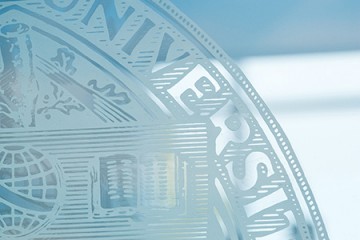A year ago this month, more than 100 students took part in a protest on Johns Hopkins University's Homewood campus to call attention to racism and discrimination on campus.
The protest, organized and led by JHU's Black Student Union, came at a time when similar demonstrations were taking place at campuses across the country, sparked by student-led protests at the University of Missouri.
It also came at a time when Johns Hopkins University leadership was taking a hard and critical look at issues of diversity and inclusion on its campuses, with a particular focus on increasing faculty diversity.
Today, Johns Hopkins University officially released a comprehensive plan that gives an overview of ongoing diversity efforts and also outlines next steps. The JHU Roadmap on Diversity and Inclusion, a blueprint of sorts for the entire university, addresses key issues raised at an open forum held shortly after the aforementioned student protest—including lack of diversity among faculty, harassment, and hate speech.
It also lays out specific actions to promote diversity, inclusion, and equity across the university—among faculty, students, and staff; in the institution's stated principles, curricula, and campus climate; and in how the university engages with Baltimore.
"As stewards of this university, we are singularly and unapologetically focused on sustaining its excellence," President Ronald J. Daniels wrote in a letter introducing the document. "And, at a time when people and ideas flow freely and cross-pollinate in ever more surprising ways, our community must remain open to—and inclusive of—all. A rich diversity of people, background, experience, and thought is central to our work; to our missions of education, research, and service; and to our commitment to freedom of inquiry and expression."
To produce the roadmap, the university spent months gathering institutional data, conducting interviews with the JHU community, and soliciting public feedback on the document's draft, which was released earlier this year. The university's board of trustees endorsed the revised document in October.
The 85-page roadmap targets four key goals:
- Achieving greater diversity of membership in the JHU community
- Improving opportunity for JHU community members of all backgrounds
- Enabling robust engagement with diverse viewpoints
- Fostering a climate of respect
"This document not only illuminates our strengths as a community, but also the opportunities we have to overcome barriers in creating a truly inclusive academic culture," wrote James Page, who was named to the university's new stand-alone position of vice provost and chief diversity officer on an interim basis in August. "The road ahead will not be without obstacles, but I am confident that this journey will make us stronger and secure our place as a national and global beacon for discovery, education, and service."
The topic of faculty diversity is addressed at length in the roadmap.
The Faculty Diversity Initiative, formally announced in November 2015, aims to support more inclusive faculty searches and create a pipeline of diverse scholars. The initiative resulted in the hiring of 10 underrepresented minority tenured or tenure-track faculty members during the 2015-16 academic year, and the university has hired another 38 underrepresented minority faculty who will join Johns Hopkins during the 2016-17 academic year.
Each of the university's nine academic divisions has prepared a faculty diversity action plan and adopted new protocols for faculty searches. Daniels and Provost Sunil Kumar, who joined JHU in September, will monitor their progress.
The Faculty Mentoring Program, which launched in November 2015, supports underrepresented minority faculty members, who indicated in interviews that they had experienced isolation and a lack of networking or mentoring opportunities.
"Increasing the diversity of our faculty is not a luxury but a necessity for us," Kumar said. "With the publication of the 2016 faculty composition report this year, we have an established baseline to track our future progress and hold ourselves accountable to the community."
The recruitment and support of a diverse student body is also addressed. Resources in place include services offered by the Office of Multicultural Affairs, Student Disability Services, and LGBTQ Life.
During orientation activities in August, first-year students on the Homewood campus discussed critical aspects of diversity, inclusion, and what it means to be part of the JHU community. In response to student feedback about campus climate, by March 2017, every first-year student will attend a two-hour interactive workshop called "Identity and Inclusion at Hopkins."
The plan calls for continuing support for conversations about building an inclusive environment. Johns Hopkins offers unconscious bias training and discrimination and harassment prevention training, and it will continue to offer events focused on race and culture, including the JHU Forums on Race in America speaker series, the annual MLK Commemoration event, and cultural competency programs.
"I'm grateful for the strength of President Daniels' leadership in rallying the Hopkins community around the creation of this roadmap," Diversity Leadership Council Chair Ashley Llorens wrote in an emailed statement. "The breadth of our notion of diversity—from race and ethnicity, to gender identity, disability and family support—is captured in this document. My sincere hope is that leaders all around Hopkins leverage the roadmap and the various tools and programs it captures to continue to drive us towards a more inclusive institution."
The draft roadmap was posted online in February, and the JHU community was invited to provide feedback. The Hub spoke with 10 students, none of whom had reviewed the draft document, but who said they generally felt that Johns Hopkins was an inclusive place.
Some suggested they were underwhelmed by the university's efforts to make inclusion central to the school's mission.
"Just because you are meeting a quota of underrepresented minority students doesn't mean you are encouraging the exchange of diverse ideas," said one graduate student.
Others said they weren't sure where to access resources or assistance for issues of discrimination.
"As a minority, I've never felt discriminated against on campus," a junior said, "but I wouldn't know what to do if I did."
In addition to today's release of the roadmap, the university has also launched a website that gives members of the Johns Hopkins community access to news and events related to diversity and links to organizations, offices, and resources that support inclusion and assist individuals across the institution.
"I'm glad to see Hopkins making such a public commitment to improving campus climate and culture," said Demere Woolway, director of LGBTQ Life. "I hope it inspires everyone to consider what they can do to make Hopkins more inclusive."
Posted in University News
Tagged diversity












